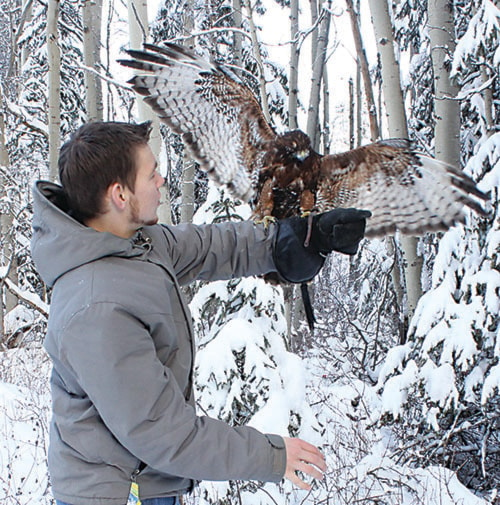Hunting is a popular sport in Vanderhoof but only a hand full of students are learning it ‘bird-of-prey’ style.
Falconry dates back thousands of years and means to hunt wild quarry using a trained bird. A falconer flies a falcon and an austringer flies a hawk, just as students at Northside Christian School do with Shay, a one-and-a-half year old red-tail.
Part of the course is raptor identification, bird anatomy, trapping and caring for the bird. However, training the bird to hunt proves to be the most exciting part of the class.
Jaedon Voth, Gr 12 student, says the only way to train him is to use positive reinforcement.
“Their only interest is food and they will always want to feel full so that’s why positive reinforcement works.The bird is like a dog, you can only train it by saying good job. You never say ‘bad bird’,” Jaedon said.
Shay typically eats 40-60 grams per day but if he were to catch a rabbit, he can take around 200g at a time, a quarter of his weight, and store the food in his crop (neck). This is why positive reinforcement works for training as they don’t get full quickly, Jaedon said.
Students hunt with Shay in the wooded area by their school. The bird is thrown up into a tree and called by whistle to follow the group. A bell around his ankle reveals his whereabouts but pieces of meat are what get Shay’s attention. “She just thinks of humans as a good food provider, not anything cool to hang out with,” Emily Fisher, licensed falconry instructor said, as she stretches out her arm while tapping her hand signalling the bird to come. The ultimate goal is to get the bird to hunt and follow you into the brush but, first you must get the bird to come to your fist she said.
“Falconers wear gauntlets (gloves) so they don’t get skewered by the bird’s talons. Usually they don’t mean to hurt you but if you have your hands in the wrong place at the wrong time they might think you are after their food and they could make a grab at your hand.,” Ms. Fisher said.
A tracker is attached to Shays two deck (centre) tail feathers incase he chases game out of sight or is chased off by other raptors. Unlike pigeons, hawks do not have a sense of home and would therefore not make good messengers.
“She just thinks of humans as a good food provider, not anything cool to hang out with,” Ms. Fisher said.
Pigeons are actually used as bate when the students learn to trap with the flip net dho-ghazza, a net-style trap. Janessa Reimer, Gr 12 student, says she doesn’t feel bad trapping birds because the odds just aren’t in their favour.
“Only a small percentage (10-30 per cent) of young survive in the wild so, as long as you don’t take an adult whose breeding, you can keep it because it would probably die anyway,” Janessa said.
To complete the falconry course the students must write a final apprenticeship exam which include a hands-on portion. In BC you need a wildlife permit to have a raptor. If interested in bird-of-prey hunting, call Emily Fisher at Northside Christian School at 250-567-9335.
